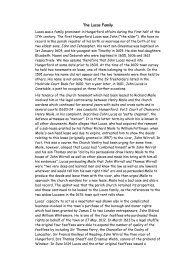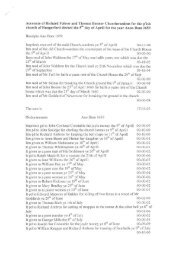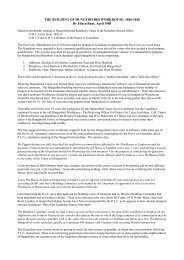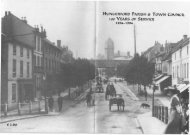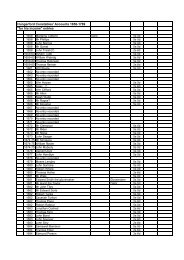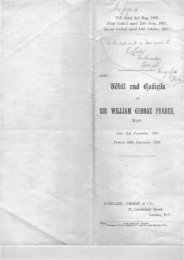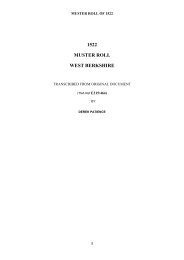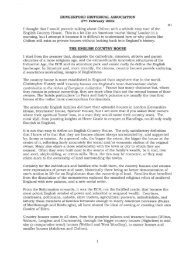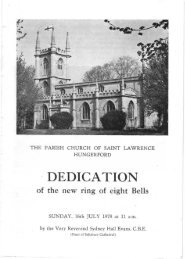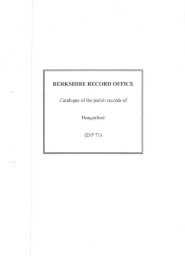Denford Park, Kintbury - Hungerford Virtual Museum
Denford Park, Kintbury - Hungerford Virtual Museum
Denford Park, Kintbury - Hungerford Virtual Museum
You also want an ePaper? Increase the reach of your titles
YUMPU automatically turns print PDFs into web optimized ePapers that Google loves.
<strong>Denford</strong> <strong>Park</strong>, Kintburv. Berkshire<br />
2.2 <strong>Denford</strong> <strong>Park</strong><br />
In 1810 Sir Walter James had sold <strong>Denford</strong> to William Hallett of Townhill,<br />
Hampshire, a fairly influential MP. Hallett was responsible for the building a new<br />
mansion, away from the riverside and up on the slope overlooking the valley. It was<br />
built to the designs of the then highly fashionable architect, Jeffrey Wyattville in<br />
about 1815. 17<br />
Wyattville (1766-1840) was a younger member of a dynasty of architects that<br />
originated in Staffordshire in the mid-18 th century; the 'ville' at the end of his name<br />
was added by permission of George IV after he started work remodelling Windsor<br />
Castle, his most famous and long-term project.<br />
The most famous Wyatt was his uncle, James - brilliant at times but also rather<br />
unreliable. Jeffrey, who spent several years as his assistant, was, on the other hand,<br />
perhaps less able but better organised and dependable and set up his own practise in<br />
1799.<br />
In 1806, Joseph Farington of the Royal Academy recorded a visit by Jeffrey in his<br />
diary; at that time he was still becoming established and had put a list of the houses he<br />
had designed on the back of his 'Direction Card' 'to Shew that he was a Regular<br />
Architect'; he then charged three guineas a day, and two shillings a mile for travelling<br />
- quite high fees for the time. 1<br />
By the time he designed <strong>Denford</strong> House he was one of the most prolific of country<br />
house architects in England, particularly for members of the Whig aristocracy, and<br />
from the 1820's was one of the leading architects in the country, helped by his Royal<br />
patronage. 20<br />
Hallett was still at <strong>Denford</strong> early in 1822, as he wrote a letter from there to Sir Robert<br />
Peel, the new Home Secretary. 21 Curiously, in the previous year, three deeds, now in<br />
the Devon Record Office, refer to a George Porcner of <strong>Denford</strong> House, Berkshire,<br />
clerk, eldest surviving son of Josias Du Pre Porcher; his role is unclear. 22<br />
At the end of 1822, William Hallet sold his new house and the rest of the <strong>Denford</strong><br />
estate. The sales particulars survive and are accompanied by a plan which shows the<br />
new house as a square block labelled 'Mansion'. In the accompanying schedule it is<br />
described as consisting of 'The Mansion House, lawn, plantations, gardens, Coachhouse,<br />
Stables, farmyard and buildings and the two Cottages' occupying a little over<br />
15 acres in all; 'in front' of the mansion was a park with plantations taking up another<br />
70 acres or so but the rest of the estate was still agricultural. 23<br />
17 Linstrum, D, 1972, Sir Jeffrey Wyattville, Architect to the King, 235; in 1808 a William Hallett from<br />
Berkshire wrote to the architect John Nash (BL Add. 28670 ff.89-90), but the contents have<br />
not been examined.<br />
18 Colvin, H, 1995, A Biographical Dictionary of British Architects 1600-1840, 1129<br />
19 Greig, J (ed.), 1924, The Farington Diary Vol. IV, 32<br />
20 Colvin, op. cit., 1129<br />
21 BL Add. 40347 f.281<br />
22<br />
Devon Record Office 1926 B/BC/T/2/21-23 (not examined)<br />
23 Berkshire Records Office D/EX 1060/2/3<br />
-7-<br />
Richard K Morriss & Associates, Historic Buildings Consultants, Bromlow House, Bromlow, Shropshire, SYS OEA




